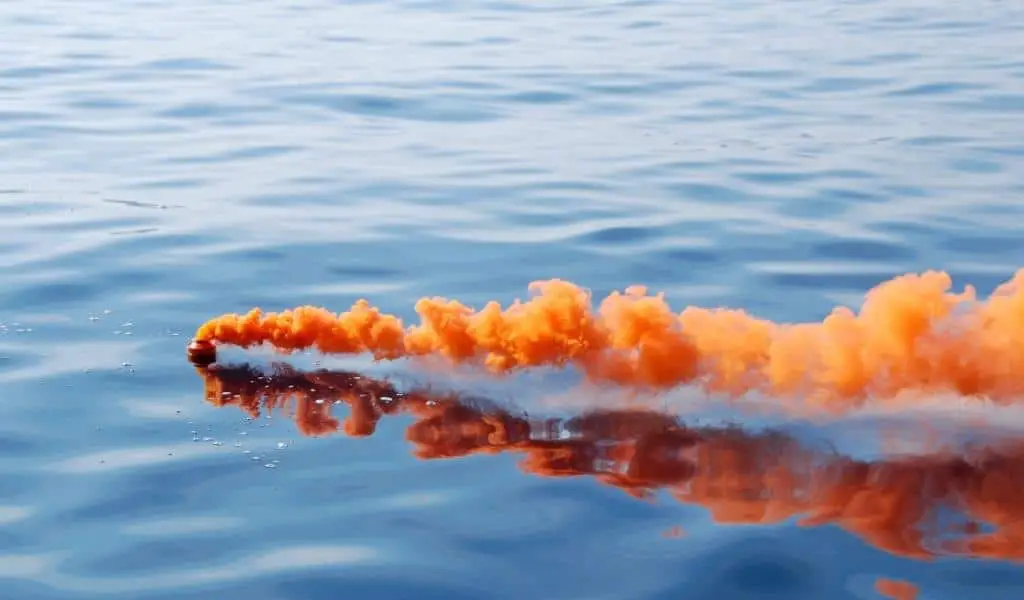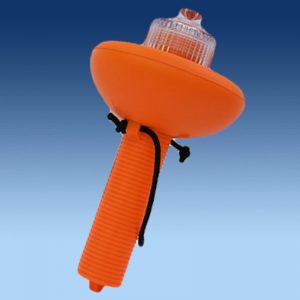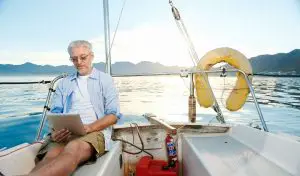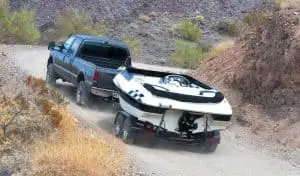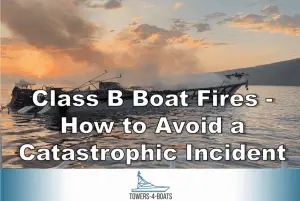All boat owners are legally required to meet minimum safety standards, even if they only use it for recreation. You’ll probably be wondering if you need flares for your boat?
For boats less than 16ft, you only need flares or distress signals between sunset and sunrise. This can be one distress light or three red flares. For boats longer than 16ft, you must always have flares or distress signals. This can be either one distress light and one distress flag, one distress light and three smoke signals, or three red flares.
As a boat owner, you may be too excited to get out on the water to think much about the hazards you might encounter, but those hazards are very real. In some cases, they can be deadly. While government oversight can be a pain, those safety requirements exist for for our own good. Whenever we do anything outdoors and especially around water, it’s best to remember the following motto:
Be prepared! So, what exactly are we required to carry on board of our recreational boat? Well, it depends on a few things. Here is a list of what you need to consider before your boat is ready to hit the waves.
What Are the Requirements?
Visual distress signals (VDSs) are designed so that boaters can signal for help if they are in distress and unable to save themselves. Under U.S. law, all boats must be equipped with VDSs while operating on coastal waters, the Great Lakes, the territorial or high seas, and any other connecting body of water that is more than two miles wide. Your state might have additional laws, so you should always double-check to make sure you are in compliance with every law that applies to you and your boat.
The federal requirements are as follows:
For boats under 16′ in length:
Distress signals are only required if the boat is operating between sunset and sunrise. During this time, one electric distress light or three combination day/night red flares are required.
For boats 16′ in length or greater:
- One orange distress flag and one electric distress light OR
- Three hand-held or floating orange smoke signals and one electric distress light OR
- Three red flares for combined day/night use, which can be handheld, meteor or parachute type
If your boat is over 16 feet, you must carry VDSs. The exceptions to this requirement are:
- Vessels on lakes (except the Great Lakes)
- Sailboats under 26 feet that do NOT have propulsion machinery
- Manually propelled boats
- Boats participating in organized events
For the above vessels, VDSs aren’t required. Non-pyrotechnic devices and electric distress lights may also be acceptable under certain situations.
Types of Visual Distress Signals
A diverse range of signaling devices can be carried onboard to meet the legal requirement for VDSs. There are two general types: pyrotechnic and non-pyrotechnic.
Besides recreational boats less than 16 feet, all other boats must carry both night and day signaling devices. Any combination can be carried as long as they add up to three signals for day use and three signals for night use. Having three VDSs designed for both day and night use meets both requirements.
The following combinations of distress signals can be used to satisfy the VDS law:
- Three hand-held red flares (for dual daytime and nighttime use)
- One hand-held red flare and two parachute flares (daytime and nightime use)
- One hand-held orange smoke signal (daytime use)l, two floating orange smoke signals (daytime use) and one electric distress light (nighttime use only)
Note: If you opt for a pyrotechnic VDS, a minimum of three have to be carried onboard. Pyrotechnic devices come with an expiration date. Usually, it’s 42 months from the date of manufacture. To meet carriage requirements, you must have at least three un-expired flares aboard. You can choose to carry expired flares as backup, but they won’t count towards the legal requirement.
Pyrotechnic Visual Distress Signaling Devices
These types must be Coast Guard-approved, in good working condition, and stowed in an accessible place. If they are marked with an expiration date, this date must not have passed. Launchers produced before Jan. 1, 1981, intended for use with approved signals aren’t required to be Coast Guard Approved.
USCG Approved Pyrotechnic Visual Distress Signals and Associated Devices include:
- Pyrotechnic red flares, handheld or aerial
- Pyrotechnic orange smoke, hand held or floating
- Launchers for aerial red meteors or parachute flares
The purpose of this rule is to make sure that boaters have a way of attracting attention and getting help if they ever find themselves in an emergency. When used the right way, VDSs will also help reduce the time it takes to find a boat during a search. This lessens the possibility of a minor emergency becoming a tragedy.
Non-pyrotechnic Visual Distress Signaling Devices
This type must carry the manufacturer’s certification that they meet Coast Guard requirements. They must be in good working order and stowed to be readily accessible. This group includes:
- Orange distress flag
- Electronic distress light
Types of VDSs for Daytime Use Only
1. Handheld Orange Smoke Distress Signals
Hand held distress signals are very common. Make sure to hold the flare with a glove, and make sure to keep the smoke downwind of your boat.
2. Floating Orange Smoke Distress Signals
These come in two varieties. There is one that last 5 minutes and another that lasts 15 minutes.
3. Orange Distress Signal Flag for Boats
The distress flag must be at least 3 x 3 feet with a black square and ball on an orange background. It is accepted as a day signal only and is especially effective in bright sunlight. The flag is most distinctive when waved on something such as a paddle or a boat hook or flown from a mast.
4. Sea-Marker Dye
This is useful when air search is underway. The dye is available in several different colors and should be used when chances of being spotted are high.

5. Signal Mirror
Although not recognized by USCG as a carriage requirement, a well-handled signal mirror can be very effective in calling attention to oneself. It is low in cost and has an unlimited shelf life.
The handheld and the floating orange smoke signaling devices are excellent (if not the best) day signals, especially on clear days. Both signals are most effective with light to moderate winds. However, in higher winds the winds tend to disperse the orange signal cloud which makes it harder to see.
Types of VDS for Night Time Use Only
1. SOS Electric Distress Light for Boats
The electric distress light must automatically flash the international SOS distress signal, which is known to most boaters all over the world. The SOS Distress Light meets U.S. Coast Guard requirements and can replace traditional pyrotechnic flares. Unlike traditional flares, this electronic flare never expires, eliminating any worries you might have related to disposing expired flares.
The LED light flashes only the SOS sequence which is in accordance with USCG requirements. It can be visible up to 10 nautical miles away for up to 60 hours, compared to a traditional flare that can last for a minute or less.
NOTE: An ordinary flashlight is not acceptable as a distress light. The flashes have to be operated by hand, and their power is comparatively weak.
Types of VDS for Anytime Use
Here are the different types of distress signal for use either in the day or at night. I have listed these in order of visibility distance, starting with the shortest (handheld) and ending with furthest (parachute flare).
Some of the following may need to be used in combination with a suitable launching device.
1. Handheld Flare Distress Signal
A handheld flare is one of the most affordable types of distress signal that can be used during the day or at night. They will have a protective handle to ensure you can deply them safely.
A handheld flare will generally be visible up to 5 miles away.
2. Rocket Propelled Meteor Distress Flare (12 Gauge)
It goes without saying that a rocket propelled flare is going to be more visible than a handheld flare, however keep in mind that they only burn for 7 seconds.
The 12 gauge is the smallest type of rocket propelled red distress flare, usually visible up to 21 miles away.
3. Rocket Propelled Meteor Distress Flare (25mm)
A 25mm distress flare is twice as bright as the 12 gauge, although generally burns for the same amount of time.
Whilst you are not legally obliged to have 25mm aerial flare, they have a slightly increased visibility up to 27 miles. Again, these must be red.
4. Parachute Red Flare Distress Signals (25 mm or larger)
A 25mm parachute red flare distress signal has the longest visibility distance, usually around 47 miles away.
This Orion Safety 800 parachute red flare will last for 40 seconds once fired. However, keep in mind that it’s one of the most expensive types of pyrotechnic signal.
No one single signaling device is ideal under all conditions and for all purposes. Therefore, you might want to think about carrying a few different types. For example, an aerial flare can be seen over a long distance on a clear night. But for closer work, a handheld flare might be better.
Flare FAQs
What Type of Flares Do I Need?
There are many types of flares that you can choose from depending on your boating habits.
For Inland Boating:
If you seldom leave sight of land, you should carry:
- Handheld red flares AND/OR
- Aerial Flares, such as 12-gauge HP or Skyblazer XLT Signals
For Coastal Boating:
If you travel offshore occasionally and you don’t stay out overnight, you should carry:
- Handheld red flares AND
- Aerial Flares, such as 12-gauge HP or Skyblazer XLT Signals AND
- Smoke Flares, such as an orange handheld
For Offshore Boating:
If you travel offshore occasionally and you don’t stay out overnight, you should carry:
- Handheld Flares: SOLAS Approved AND
- Aerial Flares: 25MM or SOLAS Approved AND
- Smoke Flares: Floating SOLAS Approved
How Do I Know If a Flare Meets the Coast Guard Requirements?
Only visual signals marked with a U.S. Coast Guard approval or certification number meet the Coast Guard requirements.
How Many Signals Do I Need to Carry?
If you decide to use pyrotechnic signals to meet the Coast Guard VDS requirements, a minimum of three must be carried. Any combination of the signals can be carried as long as they add up to three signals for day use and three signals for night use. Remember that while three signals are the legal minimum, search and rescue experts recommend carrying at least six signals onboard.
Will My Flares Expire?
Pyrotechnic signaling devices (including aerial flares and hand held signals) expire 42 months after the date of manufacture, which complies with Coast Guard guidelines. Typically, this means that you must replace your flares every three boating seasons. Remember to check your fire extinguishers because they have a limited shelf life too.
Which Flare is Right for Me?
All distress signaling devices have both advantages and disadvantages. The most popular are probably the smaller pyrotechnic devices because of their relatively low cost. They make excellent distress signals because of their visibility, but they can be used only once. Additionally, they can be hazardous if not properly handled.
Pyrotechnics devices have a very hot flame which can cause burns and ignite flammable material, such as clothing. Projected devices are very similar to traditional firearms and should be handled with the same caution. The very best flares available in terms of brightness and duration are labeled SOLAS. SOLAS-marked flares go above and beyond US Coast Guard minimums.

